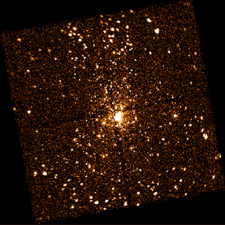January 14, 2000
CXC PR: 00-06
NASA's Chandra X-ray Observatory has resolved nearly a thousand faint X-ray-emitting stars in a single observation of young stars in the Orion Nebula. The discovery--the richest field of X-ray sources ever obtained in the history of X-ray astronomy--will be presented on Friday, January 14, at the 195th national meeting of the American Astronomical Society in Atlanta, Georgia.
The Orion region is a dense congregation of about 2,000 very young stars formed during the past few million years. The discovery of such a wealth of X-ray stars in the closest massive star-forming region to Earth (only 1,500 light years away) is expected to have a profound impact on our understanding of star formation and evolution.
"We've detected X-rays from so many fantastic objects, such as very young massive stars and stars so small that they may evolve into brown dwarfs," said Gordon Garmire, Evan Pugh Professor at Penn State University, University Park. "Chandra's superb angular resolution has resolved this dense cluster of stars with arcsecond accuracy and unsurpassed sensitivity."
Garmire leads the team using Chandra's ACIS detector, the Advanced CCD Imaging Spectrometer, conceived and developed for NASA by Penn State University and the Massachusetts Institute of Technology.
The brilliant Orion region has awed humankind for millennia. The most massive and brightest of these nascent stars are in the Orion Trapezium, which illuminates the Orion Nebula, also known as Messier 42. The Trapezium and its luminous gas can be seen with the unaided eye in the winter sky in the "sword" of the Orion constellation.
Young stars, such as those found in Orion, are known to be much brighter in X-rays than middle-aged stars such as the Sun. The elevated X-ray emission is thought to arise from violent flares in strong magnetic fields near the surfaces of young stars. The Sun itself was probably thousands of times brighter in X-rays during its first few million years.
Although the enhanced magnetic activity of young stars has been known for some time, the physical causes and evolution of the activity are poorly understood, according to Dr. Eric Feigelson, professor of astronomy and astrophysics at Penn State.
"With hundreds of stars observed simultaneously, possessing a wide range of properties such as mass and rotation rates, we hope the Orion observation will help unravel the astrophysical principles underlying this phenomenon," Feigelson said. "X-ray astronomy now penetrates as deeply into the clouds as the best infrared and optical telescopes, permitting us to study high-energy processes during the earliest phases of star formation."
"This Chandra image is a milestone in the field of X-ray astronomy and very gratifying to me personally," said Garmire. "Chandra's sensitivity is 20 times better than achieved with the best previous X-ray telescopes."
A number of the ACIS X-ray sources in the Orion observation have special importance. Several are associated with a distinct cluster of higher-mass stars deeply embedded within the murky Orion Molecular Cloud, including the infrared-luminous Becklin-Neugebauer object.
"This is the first time X-ray astronomy has resolved individual massive stars still embedded in their natal cloud," said Dr. Leisa Townsley, research associate in astronomy and astrophysics at Penn State.
At least three ACIS sources are associated with cluster members with masses so small (roughly 1/20th of the Sun's mass), that they will evolve into brown dwarfs rather than true stars.
"They more closely resemble proto-Jupiters than proto-stars," said Dr. Yohko Tsuboi, visiting research scholar in astronomy and astrophysics at Penn State. "Over a dozen X-ray sources have no known counterpart, even in the most sensitive Hubble Space Telescope or infrared studies. These too may be very low-mass stars."
The ACIS team studying the Orion X-ray source includes Profs. Feigelson and Garmire and research scientists Patrick Broos, Leisa Townsley, and Yohko Tsuboi at Penn State; Steven Pravdo at the Jet Propulsion Laboratory; and Lynne Hillenbrand at the California Institute of Technology.
NASA's Marshall Space Flight Center in Huntsville, Ala., manages the Chandra program. TRW, Inc., Redondo Beach, CA, is the prime contractor for the spacecraft. The Smithsonian's Chandra X-ray Center controls science and flight operations from Cambridge, MA.
Other Press Room:Orion Nebula Press Release (PSU Sep 01)To follow Chandra's progress or download images visit the Chandra sites at



